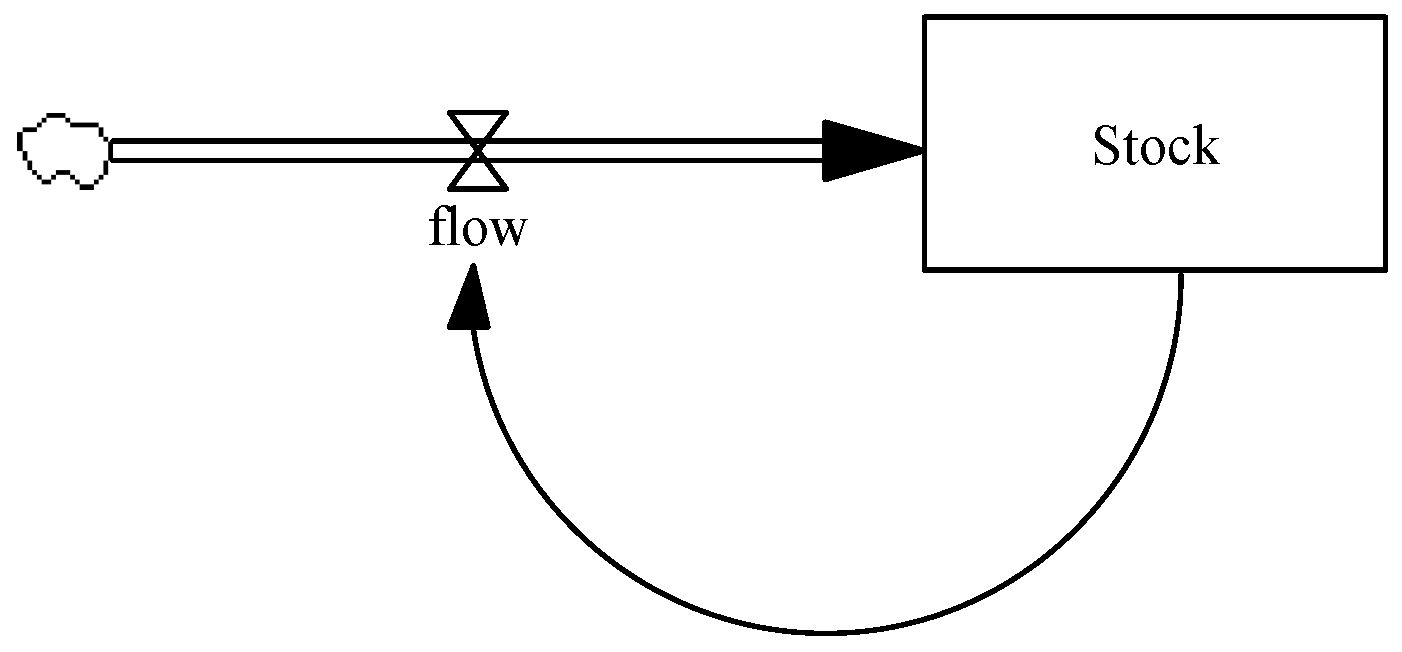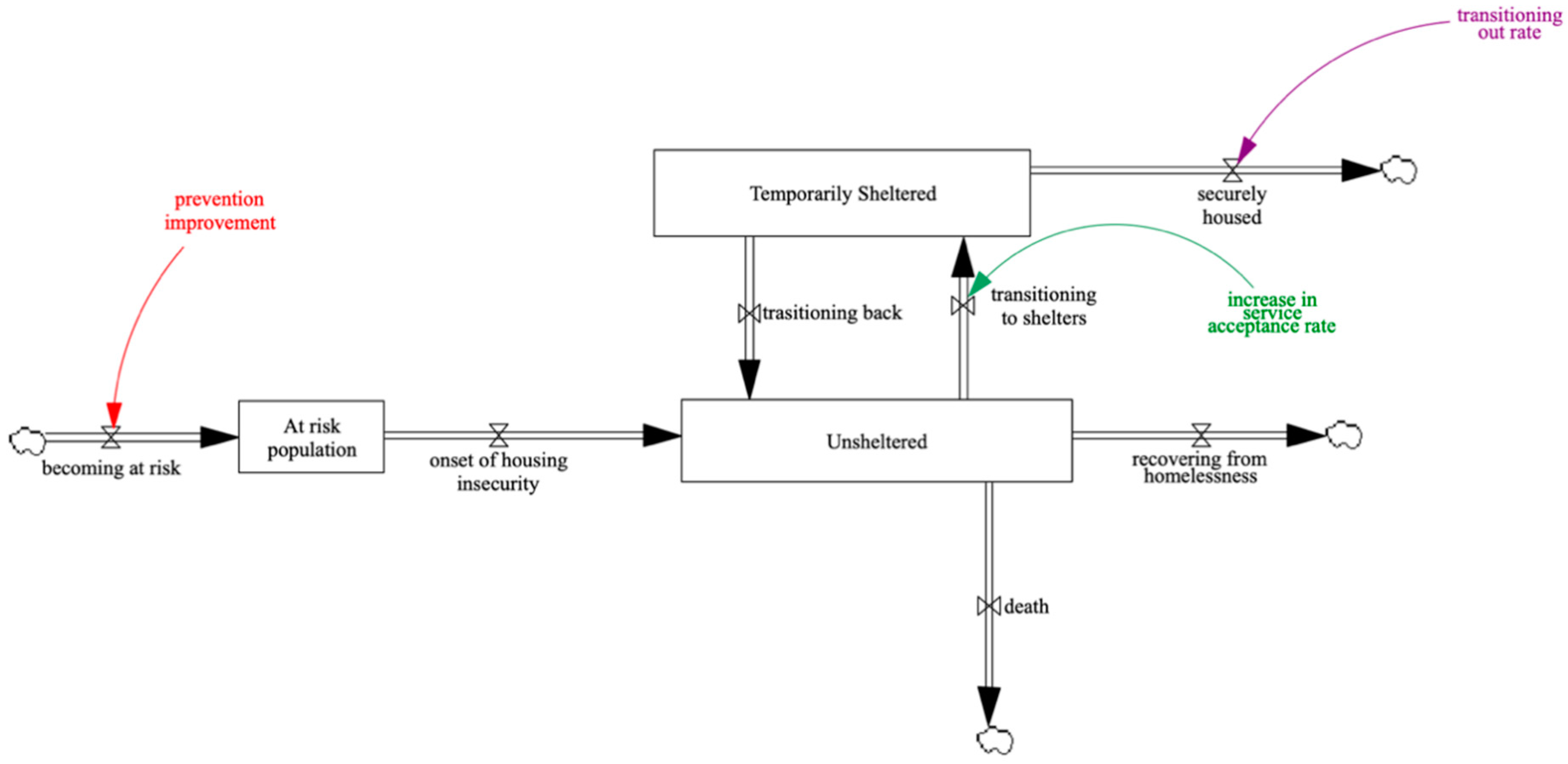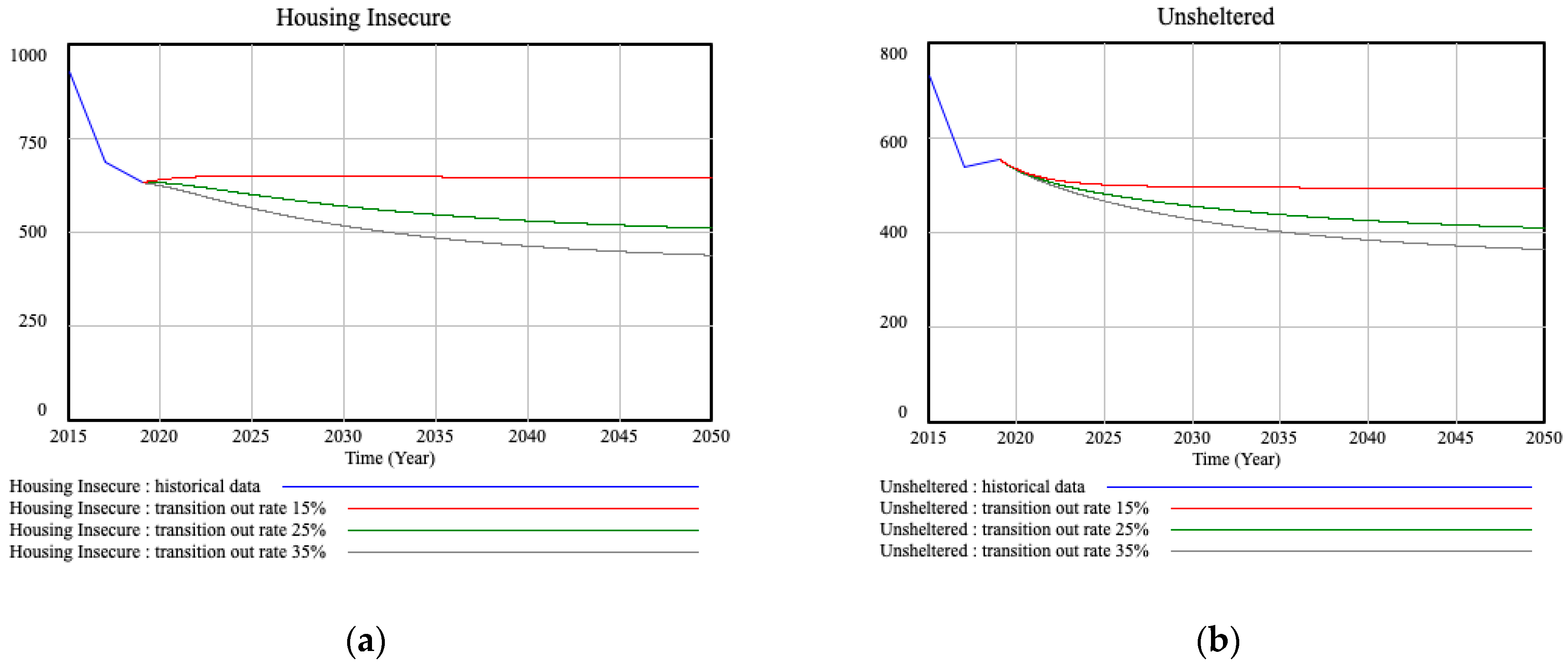Making the Case for Proactive Strategies to Alleviate Homelessness: A Systems Approach
Abstract
1. Introduction
2. Current Strategies to Address Homelessness
3. Complexity Analysis of the Issue
4. Materials and Methods
5. Results
5.1. Simulation Model Development and Structure
5.2. Policy Experiment
6. Discussion
7. Conclusions
Author Contributions
Funding
Institutional Review Board Statement
Informed Consent Statement
Data Availability Statement
Conflicts of Interest
References
- The U.S. Department of Housing and Urban Development. The 2017 Annual Homeless Assessment Report to Congress PART 2: Estimates of Homelessness in the United States. 2017. Available online: https://www.huduser.gov/portal/sites/default/files/pdf/2017-AHAR-Part-2.pdf (accessed on 15 January 2020).
- Brumley, B.; Fantuzzo, J.; Perlman, S.; Zager, M.L. The unique relations between early homelessness and educational well-being: An empirical test of the Continuum of Risk Hypothesis. Child. Youth Serv. Rev. 2015, 48, 31–37. [Google Scholar] [CrossRef][Green Version]
- Shelton, K.; Taylor, P.; Bonner, A.; van den Bree, M. Risk factors for homelessness: Evidence from a popula-tion-based study. Psychiatr. Serv. 2009, 60, 465–472. [Google Scholar] [CrossRef]
- Baggett, T.; Hwang, S.; Rigotti, N. Mortality among homeless adults in Boston: Shifts in causes of death over a 15-year period. JAMA Intern. Med. 2013, 173, 189–195. [Google Scholar] [CrossRef]
- Masten, A.S.; Fiat, A.E.; Labella, M.H.; Strack, R.A. Educating Homeless and Highly Mobile Students: Implications of Research on Risk and Resilience. Sch. Psychol. Rev. 2015, 44, 315–330. [Google Scholar] [CrossRef]
- Ji, E.-G. A study of the structural risk factors of homelessness in 52 metropolitan areas in the United States. Int. Soc. Work. 2006, 49, 107–117. [Google Scholar] [CrossRef]
- May, E. Factors Associated with Effective Help-Seeking Behavior among Homeless Persons: A Cross Sectional Study of San Diego’s Street Homeless Population. 2011. Available online: https://www.homelesshub.ca/resource/factors-associated-effective-help-seeking-behavior-among-homeless-persons-cross-sectional (accessed on 15 January 2020).
- Piat, M.; Polvere, M.; Kirst, M.; Voronka, J.; Zabkiewicz, D.; Plante, C.M.; Isaak, C.; Nolin, D.; Nelson, G.; Goering, P. Pathways into homelessness; Understanding how both individual and structural factors contribute to and sustain homelessness in Canada. Urban Stud. 2014, 52, 2366–2383. [Google Scholar] [CrossRef]
- Swick, K.J. Helping homeless families overcome barriers to successful functioning. Early Child. Educ. J. 2005, 33, 195–200. [Google Scholar] [CrossRef]
- Corinth, K. The impact of permanent supportive housing on homeless populations. J. Hous. Econ. 2017, 35, 69–84. [Google Scholar] [CrossRef]
- Fowler, P.J.; Hovmand, P.; Marcal, K.; Das, S. Solving Homelessness from a Complex Systems Perspective: Insights for Prevention Responses. Annu. Rev. Public Health 2019, 40, 465–486. [Google Scholar] [CrossRef]
- Stroh, D.P.; Goodman, M. A systemic approach to ending homelessness. Appl. Syst. Think. J. 2007, 4, 2–8. [Google Scholar]
- Ford, F.A. Modeling the Environment; Island Press: Washington, DC, USA, 2010. [Google Scholar]
- Sterman, J. Business Dynamics: Systems Thinking and Modeling for Complex World; McGraw Hill: Boston, MA, USA, 2000. [Google Scholar]
- Rolston, H.; Geyer, J.; Locke, G.; Abt Associates. Final Report: Evaluation of the Homebase Community Prevention Program; Department of Homeless Services: New York, NY, USA, 2013. Available online: https://www.abtassociates.com/insights/publications/report/evaluation-of-the-homebase-community-prevention-program-final-report (accessed on 15 January 2020).
- Goodman, S.; Messeri, P.; O’Flaherty, B. Reprint of “How effective homelessness prevention impacts the length of shelter spells”. J. Hous. Econ. 2014, 24, 101–108. [Google Scholar] [CrossRef]
- National Alliance to End Homelessness. Housing First. 2016. Available online: https://endhomelessness.org/resource/housing-first/ (accessed on 15 January 2020).
- Chabria, A.; Oreskes, B.; Luna, T. Voters Could Decide If California Cities Will Be Punished for Not Reducing Home-Lessness. Los Angeles Times. 2020. Available online: https://www.latimes.com/california/story/2020-01-13/homeless-housing-task-force-california-constitutional-amendment (accessed on 15 January 2020).
- National Alliance to End Homelessness. What Causes Homelessness: Connecting Homelessness and Health. Available online: https://endhomelessness.org/homelessness-in-america/what-causes-homelessness/health (accessed on 15 January 2020).
- Long Beach Department of Health and Human Services. Study Sessions on Homelessness. 2016. Available online: http://www.longbeach.gov/globalassets/everyone-home-lb/media-library/documents/news/mayors-study-session (accessed on 15 January 2020).
- McQuistion, H.L.; Gorroochurn, P.; Hsu, E.; Caton, C.L.M. Risk factors associated with recurrent homelessness after a first homeless episode. Community Ment. Health J. 2013, 50, 505–513. [Google Scholar] [CrossRef] [PubMed]
- Garcia, I.; Kim, K. I felt safe: The role of the rapid rehousing program in supporting the security of families experiencing homelessness in Salt Lake County, Utah. Int. J. Environ. Res. Public Health 2020, 17, 4840. [Google Scholar] [CrossRef]
- Smith, C.; Castañeda, E. Sick enough? Mental illness and service eligibility for homeless individuals at the border. Soc. Sci. 2020, 9, 145. [Google Scholar] [CrossRef]
- Stringfellow, E.J.; Kim, T.W.; Pollio, D.E.; Kertesz, S.G. Primary care provider experience and social support among homeless-experienced persons with tri-morbidity. Addict. Sci. Clin. Pract. 2015, 10, A64. [Google Scholar] [CrossRef]
- Hughes, B.; Anund, A.; Falkmer, T. System theory and safety models in Swedish, UK, Dutch and Australian road safety strategies. Accid. Anal. Prev. 2015, 74, 271–278. [Google Scholar] [CrossRef]
- Fitch, D. Client-controlled case information: A general system theory perspective. Soc. Work. 2004, 49, 497–505. [Google Scholar] [CrossRef]
- Ottino, J.M. Complex systems. AIChE J. 2003, 49, 292–299. [Google Scholar] [CrossRef]
- Albin, S.; Forrester, J.W. Building a System Dynamics Model. Part 1: Conceptualization; Massachusetts Institute of Technology: Cambridge, MA, USA, 1997. [Google Scholar]
- Wheat, I.D. What can system dynamics learn from the public policy implementation literature? Syst. Res. Behav. Sci. 2010, 27, 425–442. [Google Scholar] [CrossRef]
- Kuhn, R.; Culhane, D.P. Applying cluster analysis to test a typology of homelessness by pattern of shelter utilization: Results from the analysis of administrative data. Am. J. Community Psychol. 1998, 26, 207–232. [Google Scholar] [CrossRef]
- The U.S. Department of Housing and Urban Development. Homeless Emergency Assistance and Rapid Transition to Housing: Defining “Chronically Homeless”. 2015. Available online: https://www.hudexchange.info/resource/4847/hearth-defining-chronically-homeless-final-rule/ (accessed on 15 January 2020).
- Kushel, M.; Perry, S.; Bangsberg, D.; Clark, R.; Moss, A.R. Emergency department use among the homeless and marginally housed: Results from a community-based study. Am. J. Public Health 2002, 92, 778–784. [Google Scholar] [CrossRef] [PubMed]
- Hewett, N.; Halligan, A. Homelessness is a healthcare issue. J. R. Soc. Med. 2010, 103, 306–307. [Google Scholar] [CrossRef] [PubMed]
- Long Beach Department of Health and Human Services. Point-in-Time Homeless Count Results. 2019. Available online: http://www.longbeach.gov/globalassets/city-manager/media-library/documents/memos-to-the-mayor-tabbed-file-list-folders/2019/june-3--2019---homeless-services-update---2019-point-in-time-homeless-count-results_ (accessed on 15 January 2020).
- Skinner, S.; Rankin, S. Shut Out: How Barriers Often Prevent Meaningful Access to Emergency Shelter. Homeless Rights Advocacy Project. 6. 2016. Available online: https://digitalcommons.law.seattleu.edu/hrap/6 (accessed on 15 January 2020).
- Long Beach Department of Health and Human Services. Point-in-Time Homeless Count Results. 2020. Available online: http://www.longbeach.gov/globalassets/city-manager/media-library/documents/memos-to-the-mayor-tabbed-file-list-folders/2020/june-12--2020---homeless-service-update---2020-point-in-time-homeless-count-results-revised (accessed on 18 December 2020).
- Long Beach Department of Health and Human Services. Point-in-Time Statistic Summary. 2020. Available online: http://www.longbeach.gov/globalassets/health/homeless-services-divsion/homeless-count/clb-homeless-count-infographic-06-16 (accessed on 18 December 2020).
- Rhoades, H.; Winetrobe, H.; Rice, E. Pet ownership among homeless youth: Associations with mental health, service utilization and housing status. Child. Psychiatry Hum. Dev. 2015, 46, 237–244. [Google Scholar] [CrossRef] [PubMed]
- Gaetz, S. Making the prevention of homelessness a priority: The role of social innovation. Am. J. Econ. Sociol. 2020, 79, 353–381. [Google Scholar] [CrossRef]
- Spinney, A.; Beer, A.; MacKenzie, D.; McNelis, S.; Meltzer, A.; Muir, K.; Peters, A. Ending Homelessness in Australia: A Redesigned Homelessness Service System. 2020. Available online: https://www.ahuri.edu.au/__data/assets/pdf_file/0027/65952/AHURI-Final-Report-347-Ending-homelessness-in-Australia-A-redesigned-homelessness-service-system.pdf (accessed on 18 December 2020).
- Fitzpattick, S.; Mackie, P.; Wood, J. Homelessness Prevention in the UK: Policy Briefing. 2019. Available online: https://housingevidence.ac.uk/wp-content/uploads/2019/07/Homelessness-Prevention-in-the-UK-Policy-Brief-July-2019-final.pdf (accessed on 18 December 2020).
- Abrams, S. A Few Months in, Here’s How Much Money LA County’s Measure H Has Generated to Help the Homeless. 2018. Available online: https://www.google.com/amp/s/www.dailynews.com/2018/02/08/just-a-few-months-in-la-countys-measure-h-has-generated-millions-to-help-the-homeless/amp/ (accessed on 15 January 2020).



| P2 | ||||||||||
|---|---|---|---|---|---|---|---|---|---|---|
| 0% | 5% | 10% | ||||||||
| P3 | P3 | P3 | ||||||||
| 0% | 5% | 10% | 0% | 5% | 10% | 0% | 5% | 10% | ||
| P1 | 5% | never | >30 Y | 28 Y | never | >30 Y | 25 Y | never | >30 Y | 24 Y |
| 15% | never | 23 Y | 14 Y | >30 Y | 16 Y | 11 Y | >30 Y | 15 Y | 10 Y | |
| 25% | >30 Y | 15 Y | 11 Y | 20 Y | 10 Y | 8 Y | 17 Y | 9 Y | 8 Y | |
Publisher’s Note: MDPI stays neutral with regard to jurisdictional claims in published maps and institutional affiliations. |
© 2021 by the authors. Licensee MDPI, Basel, Switzerland. This article is an open access article distributed under the terms and conditions of the Creative Commons Attribution (CC BY) license (http://creativecommons.org/licenses/by/4.0/).
Share and Cite
Nourazari, S.; Lovato, K.; Weng, S.S. Making the Case for Proactive Strategies to Alleviate Homelessness: A Systems Approach. Int. J. Environ. Res. Public Health 2021, 18, 526. https://doi.org/10.3390/ijerph18020526
Nourazari S, Lovato K, Weng SS. Making the Case for Proactive Strategies to Alleviate Homelessness: A Systems Approach. International Journal of Environmental Research and Public Health. 2021; 18(2):526. https://doi.org/10.3390/ijerph18020526
Chicago/Turabian StyleNourazari, Sara, Kristina Lovato, and Suzie S. Weng. 2021. "Making the Case for Proactive Strategies to Alleviate Homelessness: A Systems Approach" International Journal of Environmental Research and Public Health 18, no. 2: 526. https://doi.org/10.3390/ijerph18020526
APA StyleNourazari, S., Lovato, K., & Weng, S. S. (2021). Making the Case for Proactive Strategies to Alleviate Homelessness: A Systems Approach. International Journal of Environmental Research and Public Health, 18(2), 526. https://doi.org/10.3390/ijerph18020526




